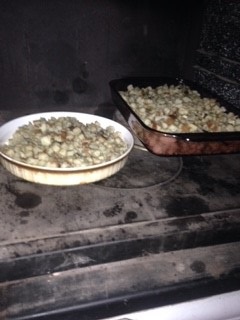I think that when most people hear the phrase "biscuits and gravy," they think of the wonderful combination of breakfast sausage and white gravy poured over biscuits. This dish is a traditional favorite from the southern United States which has steadily gained so much popularity in the north that it is now on our school lunch menu. I can remember the first time I tasted that dish. We were visiting my dad's older sister at her home in Tennessee near where her husband had grown up, and she had set out to give us a sampling of all of the southern foods that she had learned to cook.
Grandma Marian, my mother's mother, had been serving us her own version of biscuits and gravy for a long time before that. I don't know whether this dish originated with her, but I know that I've never seen anyone outside our family make it. At Grandma's house, roast beef frequently appeared on the menu. As long-time cattle producers, our family has always done our part to support the beef market, and to this day, I believe I could sit down to a dinner of roast beef and some sort of potato every noon and never get tired of it. Grandma is an expert when it comes to roast beef. Each of her roasts was always perfectly cooked and carefully seasoned with salt, pepper, and plenty of bay leaves, and her gravy was legendary.
If any beef and gravy were left over, they would appear a day or so later in this delicious entrée, which is particularly suited to being made on a woodburning cookstove. Grandma always baked this in a glass baking dish. Sometimes such a small amount was left over that everything fit in a dish that was only about six inches in diameter; other times so much would be left over that it would be made in a 6x12 rectangular casserole dish.
Our Sunday dinner one recent weekend was a beef roast cooked in the method that I wrote about in the post called
"Automatic" Cooking on a Woodburning Cookstove. As neither Nancy nor I felt like having gravy that day, I refrigerated all of the leftovers, including the generous amount of liquid in the bottom of the roaster. A few days later, we had Grandma Marian's Biscuits and Gravy for our supper. Here is what to do to make it:
1. Build your fire so that you will soon have a hot oven (400-425 degrees).
2. If you are going to make your biscuits from scratch, put your shortening in the warming oven, on top of the reservoir, or wherever it will melt for you. Later, you'll mix your cold milk or buttermilk into the melted shortening, which will cause it to congeal again. This way, you save having to cut your shortening into your flour.
3. While the oven is heating, either make your gravy or reheat any leftover gravy. While it is still on the stove, cut the leftover roast beef into chunks and add it to the gravy to heat. Grandma would sometimes add chunks of any carrots that had been cooked with the roast, or she would add peas to the gravy so that this could be a one-dish meal.
 |
The shortening for the biscuits melting in the sauce dish
in the warming oven while the gravy cooks directly over the fire. |
4. Once the meat and gravy are thoroughly heated, remove them to a casserole dish of a size suitable so that the gravy doesn't go much more than halfway up the sides of the dish. This is important because you don't want the gravy to boil over onto your oven floor. Keep the dish of gravy warm while you mix your biscuits.
 |
| The beef and gravy resting on the opened warming oven door. |
5. Either roll and cut your biscuits or drop them by spoon on the top of the hot gravy.
 |
Nancy and I agreed that these were the best biscuits that I have
ever made. Unfortunately, I only measured the flour; I just
guessed on the shortening, buttermilk, and baking powder, so
I'm going to have to practice to recreate them. |
6. Slide everything into your hot oven and bake until the biscuits are a fairly deep brown.
Keep two things in mind as you do this. You want to be sure to give the biscuits plenty of time to bake because if you don't, they will be very doughy since their bottoms are steamed by the gravy. Also, don't let your fire get your oven too hot. If you do, the tops of the biscuits will be too brown before the center of the biscuits is thoroughly baked.
 |
Our recent rescue kitten "Charlotte" soaking up the heat from the
cookstove. Our joke is that if we had known how much time she
was going to spend under the stove, we would have named her "Cinderella." |
7. To serve, I like to drizzle a little honey over the whole mess, but that is really unnecessary. I just come from a terribly long line of sweet tooths. --Hmmm. My computer doesn't like "sweet tooths," but I'm pretty sure that it isn't right to say that I come from a long line of sweet teeth.
 |
Put a dish of some kind of fruit alongside of this, and you have
one delicious repast. |
Has anyone else eaten this dish before? I'd be interested to know if others make this same thing. Let me know in the comments below. Enjoy!

























